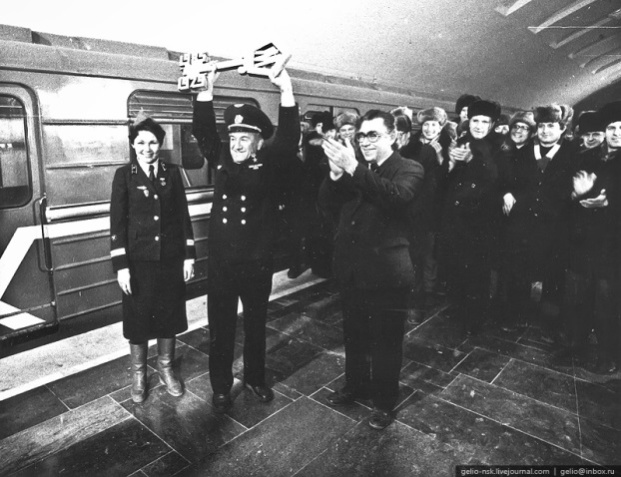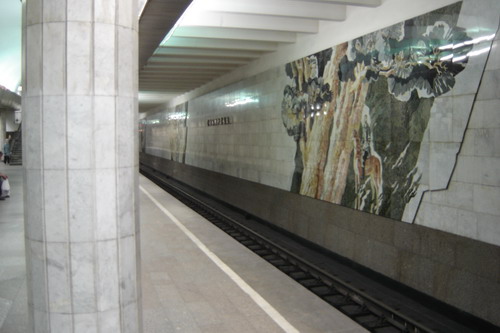Read the text and complement it with more details from the history and present-day operation of the Novosibirsk Metro
First proposed in the early 1960s, the Novosibirsk metro got official approval 15 years later. The project had a key role for the rapid transit in the city because fast and convenient public transport was crucial for the extended city areas on both banks of the Ob River. The negotiations lasted for several years, as the authorities of Novosibirsk could not make a choice between an underground railway and a high-speed tram. In 1968, government officials decided in favour of the metro, but the project required new approaches in engineering and financing. The Government of the USSR did not guarantee the financing until 1975. The Council of Ministers approved the project in 1978 after violent discussions and exchanging of ideas. They chose the deliberate engineering decision of the first metro section that included the part of the Lenin line from Zaelitsovskaya metro station to Marx Square metro station, and a section of the modern Dzherzhinsky line from Garin-Mikhailovsky Square metro station to Sibirskaya metro station. The project also included the construction of the Elitsovskoye depot for train-sets where they can be sheltered and dispatched for service.
The next step was to carry out the preliminary study and surveys. The planning organization “Novosibirskmetroproject” and the governing body of the future metro faced the challenge of planning, constructing and operating the first Siberian underground railway under severe climatic conditions. The launch stage included five stations between Krasny Prospect and Studencheskaya metro stations. Researchers and engineers from Siberian State University of Railway Engineering largely contributed to the work. The “Bridges and Transport Tunnels” Faculty is proud of its graduates and uppermost of M. Nemilostivykh, A. Melnik, V. Tour and many others who made a major contribution to building of the Novosibirsk Metro.
The geological conditions appeared to be rather favorable for constructing shallowly located stations. It reduced the price of the project and allowed for two types of station arrangement. Some stations are single span, and others are pillar- trispan. Each station has four entrance/exits either combined with the city underground passages or built in the nearby buildings. Sibirskaya metro station with a depth of 16 metres is the deepest, “Rechnoy Vokzal” metro station is the shallowest among all the stations.
The builders drove the first pile for Oktyabrskaya metro station on May 12, 1979. They used the cut-and-cover technique for the first line between Oktyabrskaya and Lenin Square metro stations. The tunnel was dug from the surface along the flood lands of the River Kamenka. Concrete lining supported that tunnel section. The further tunnel portion was driven through the rock. The tunnel required effective ventilation because many dumper trucks removed the muck from it.
The Siberian metro was built under severe weather conditions with 45 degrees Celsius below zero in winter, and was to withstand earthquakes of up to magnitude 6 on the Richter scale. The first building crews and units from Tashkent, Moscow, St Petersburg, Minsk, Gorky, Kharkov and neighboring Siberian cities together with Novosibirsk residents did their best to construct the metro in Siberia.
In 1980, the first TBM excavated the second tunnel between Oktyabskaya and Lenin Square metro stations. The first breakthrough took place on June 19, 1980 when the TBM, operated by the Tunnel Building Subdivision№ 29, cut through the rock and appeared in the trench of Lenin Square metro station within a high degree of accuracy, thanks to the excellent survey work. The drift miners broke into cheers looking at the shield. They successfully completed the very first one-kilometer experimental driving.
The driving within the city limits faced various serious problems. The threat of breaking in dwelling houses appeared in 1984 during driving of the left interstation tunnel between Oktyabrskaya and Lenin Square metro stations. Urgent actions for stabilizing the buildings prevented ruinous consequences, but seriously affected the time of the tunnel completing.
In August 1983, the first station was faced with marble, and in June 1984 the track was laid. The builders used the rail type known as P-65 (in Russian) that reduces the noise and vibration in tunnels. The service life of this rail type is much longer as compared to other types in use. Now the total weight of rails is more than 2,000 tons and each rail section length is 25 metres.
Opened with due ceremony in the presence of the city top-ranking officials, the first line was available for use by the public on December 19, 1985. It was a celebratory event, but the official opening ceremony of the Novosibirsk Metro took place on January 7, 1986 with the first trial-passenger service (fig.21.1). A year later a short shuttle line provided access to the city railway station at Garin Mikhailovsky Square. This station is named after one of the founders of our city who was a talented Russian engineer and writer. In 2007 the facade of the Novosibirsk Metro Administration Building was decorated with the memorial plaque devoted to the first chief of Siberia’s Metro Yu. S. Lelekov, the Hero of Socialist Labour, awarded the Lenin Order, the Order of Red Banner and the Award of Honour, the highest rank awards in the USSR.

| 
|
| a - Symbolic Key to the Novosibirsk Metro presented by the builders | b - The memorial plaque devoted to the first chief of Siberia’s Metro Yu. S. Lelekov |
  
| |
| c - The celebratory event of the Novosibirsk Metro official opening |
Figure 21.1 The inauguration ceremony on January 7, 1986
Gagarin and Zaelitsovskaya metro stations were added to the Lenin line in April 1992. It almost completed the first stage of construction. These stations were the only possible way for developing public transport on the right bank of the Ob River. This section faced unforeseen high levels of ground water. That problem called for new and quite different sorts of drains. Once passenger service began, the metro line was in operation 20 hours a day, seven days a week.
In December 2000, the second line, known as the Dzerzhinsky line, began its service to the station named after a celebrated fighter pilot Marshal Pokryshkin who was born in Novosibirsk. In June 2005 this line was extended to Beryozovaya Roshcha (Birch Grove) metro station, and in October 2010 to Zolotaya Niva metro station (Golden Grain Field). The Dzerzhinsky line operated with two shuttle services up Zolotaya Niva metro station was completed. The first shuttle service was regular between Garin Mikhailovsky and Sibirskaya metro stations; and another one was between Sibirskaya and Beryozovaya Roshcha metro stations. In 2007 the second tunnel between Marshal Pokryshkin and Beryozovaya Roshcha metro stations was put into operation.

| 
|
| a - Lenin metro station of the Novosibirsk Metro. | b - Underground Passage between stations |

| 
|
| c- Marble Panel showing Siberian Resources decorates ‘Sibirskaya’ metro station at the Dzerzhinsky line | d - Stained glass decoration at Rechnoy Vokzal metro station |
Figure 21.2 The Novosibirsk metro ranks third after the metros in Moscow and St Petersburg
Currently, people on each side of the river have enjoyed a reliable and efficient mode of transport (fig.21.2). Rapid transit links the centre of the city with the main RZD railway station and the two major downtown destinations of Kalinin Square and Karl Marx Square metro stations. This is of major significance as the metro connected two parts of the city previously separated by the Ob River. Now the Novosibirsk metro operates two lines with a total length of more than 15.9 km. There are 13 stations on the Lenin line and four on the Dzerzhinsky line. Together they handle almost 20% of all passenger trips in the city with about 250,000 people a day.

Figure 21.3 Diagram of the Novosibirsk Metro
There are long-term plans to enlarge the Novosibirsk metro, and studies have shown, that the planning of the metro will have the greatest influence on the image of the city. The extension of the Dzerzhinsky line, with five more stations, and the Kirovsky line, forming the third stage of the network, has started. Construction will take place gradually and preparatory work has already started for new lines. The pre-feasibility study has been completed and submitted to the government for registration. If approval is given, the builders plan to start the line from Gusinibrodskaya to Stanislavsky metro stations (fig.21.3).
From the beginning, the Metro has maintained close cooperation with scientific and project-design organizations, involved in solving the problems of tunneling under sub-zero temperatures. They not only developed building techniques in permanently frozen ground at a depth of 10 to 25 m but also devised solutions to ecological problems. For instance, reducing of atmospheric pollution; equipping the depot with devices for recycling the water used for cleaning and washing the train-sets. This experience of constructing and operating the metro is of particular significance for other cities in our country with similar climatic conditions.
Дата добавления: 2015-01-26; просмотров: 1763;
